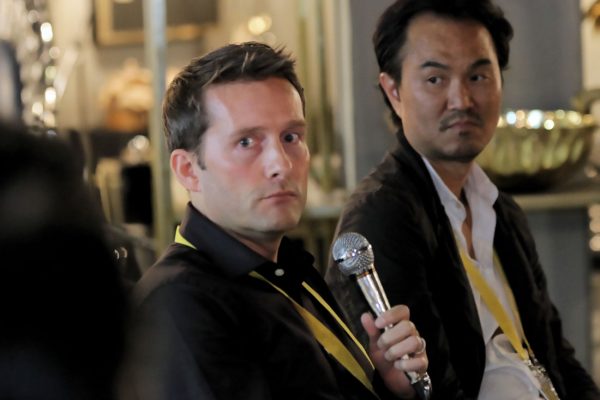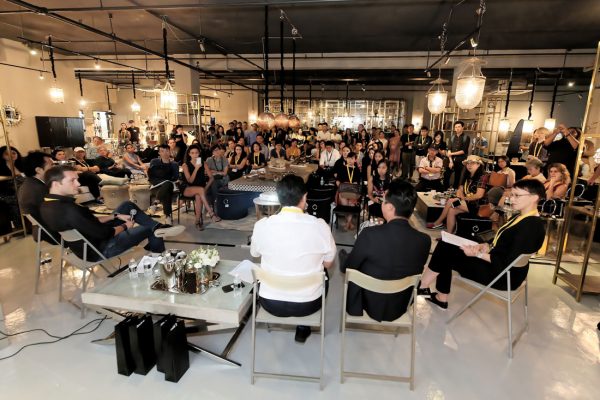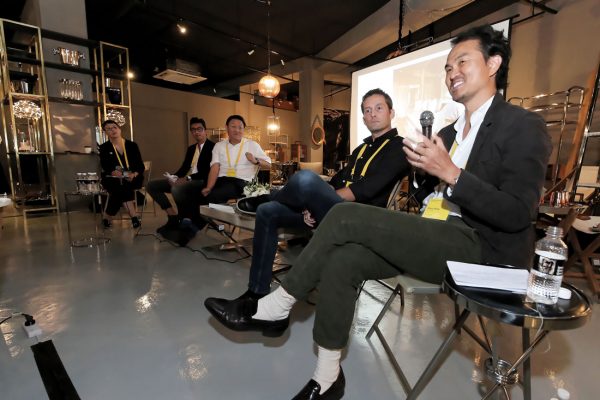Does mindset transcend jetset? Is simplicity now more valuable than gilding? We asked a panel of leading hospitality designers and experts with a #SGID Design Conversation at the Sam & Sara showroom.

November 3rd, 2017
The question of how and why consumer expectations are changing in the luxury hospitality arena is something that any designer working in this field absolutely must be able to answer. The success or failure of their projects, and the survival of their clients, depends on it.
At Singapore Indesign on 7 October our Design Conversations programme dived head first into this complex territory with the session ‘What Does “Luxury Hospitality” Mean Today?’ The full-house session was held in the new showroom of furniture brand Sam & Sara, who provided a tasty afternoon tea with a most hospitable spirit.
Our panel of speakers had a wealth of experience to share. Joris Angevaare, Creative Director of designphase dba (and one of our #SGID17 Ambassadors), was joined by Claudio Bardi, Project Director at HBA; Jinou Park, Vice President, Asia Pacific of Design Hotels; and Wong Chiu Man, Principal at WOW Architects | Warner Wong Design.

The discussion began by touching on the current state of play among the major hotel brands. “There’s a business side to this discussion, and a brand site,” said Park. “And on the brand side, the global brands are truly lost.”
Wong agreed, particularly with regard to the luxury segment. Investors will go to the brands that best fit their commercial purposes, he suggested, adding that there can be a serious lack of integrity. “Brands go where the business is,” he said.
Angevaare suggested that it’s only the smaller groups and owner-operators who can do revolutionary things. “But they tend to become amalgamated with bigger groups because as soon as something new pops up, it is bought,” he said.

So is brand still the shorthand for how people choose hotels? “There was a time when you stuck with a brand because you believed in it,” said Wong. “Now it’s because of the miles and points you can get. Developers have to know this, and designers have to react to it,” he added.
It begs the question of what is wanted – by hotel developers and guests – in a luxury hospitality experience. “Luxury can mean different things to different people and in different contexts,” said Bardi. “What experience is the person seeking?” he asked, adding that authenticity is key. For Angevaare, luxury is about control – being able to control your experience and reduce waste.
‘Experience’ is also a key concept from Park’s point of view. “The experience economy is maturing. We’re moving toward what many people would call a transformative economy. People are looking for moments of meaning and transformation, and in a hotel that’s important. Some of the niche brands are better able to provide that,” he said.
He noted that in recent times the average age of millionaires has dropped considerably. “That means this new breed of luxury travellers are asking for something very different. They also come with an idealistic, can-do attitude,” he said, and that is translated to what they want to consume. “It’s an important undercurrent driving this act of transformation,” he added.
Park sees luxury guests nowadays seeking the coming together of likeminded people – and discussed the Design Hotels project La Granja in Ibiza, where guests seek a remote and sparse farm environment for a niche, programme-rich and transformative experience at a luxury price point.

Wong pointed out that there are two broad categories of investors/owners: institutional investors with a solid business angle, and newer players who may seek a ‘return on ego’ as well as a return on investment. From the guest perspective, he also sees two camps: those favouring conspicuous consumption (often the new rich) and those who are suspicious of it. “Designers see the rainbow of these extremes. We need to push the conversation along to the things we all need to be aware of.”
He and his team had an opportunity to do so in a recent project, St Regis Maldives, where the design and the programming (developed by the same team) encouraged awareness of the fragile ecology of the location. Wong emphasised the need for designers to reclaim lost ground – “to help create the world as we want to see it. That needs a certain amount of control and the regaining of leadership,” he said.
It emerged that there are many ways to interpret luxury, but that consistency of concept is vital. What are the speakers’ personal ideals for luxury experience? For Bardi it’s escape, disconnection, and new experiences. For Angevaare, it’s being with the people he treasures in an environment that ‘better than home.” For Wong, it’s comfort – both visual and physical. And for Park? Learning and experiencing something new.
Photography by Wilson Pang.
A searchable and comprehensive guide for specifying leading products and their suppliers
Keep up to date with the latest and greatest from our industry BFF's!

Sub-Zero and Wolf’s prestigious Kitchen Design Contest (KDC) has celebrated the very best in kitchen innovation and aesthetics for three decades now. Recognising premier kitchen design professionals from around the globe, the KDC facilitates innovation, style and functionality that pushes boundaries.

The Sub-Zero Wolf showrooms in Sydney and Melbourne provide a creative experience unlike any other. Now showcasing all-new product ranges, the showrooms present a unique perspective on the future of kitchens, homes and lifestyles.

Savage Design’s approach to understanding the relationship between design concepts and user experience, particularly with metalwork, transcends traditional boundaries, blending timeless craftsmanship with digital innovation to create enduring elegance in objects, furnishings, and door furniture.

Marylou Cafaro’s first trendjournal sparked a powerful, decades-long movement in joinery designs and finishes which eventually saw Australian design develop its independence and characteristic style. Now, polytec offers all-new insights into the future of Australian design.

Gray Puksand’s construction-focused facility at TAFE NSW responds to the critical need for a resilient Australian construction industry.

In our series spotlighting aficionados across the design industry, we spoke with Alexandra Guglielmino, who leads the Art Advisory team at Bluethumb Art Gallery.
The internet never sleeps! Here's the stuff you might have missed

In our series spotlighting aficionados across the design industry, we spoke with Alexandra Guglielmino, who leads the Art Advisory team at Bluethumb Art Gallery.

A school in India, designed by Vijay Gupta Architects, showcases the importance of the natural world by engaging and educating the young.

From the trailblazer of Spanish industrial design comes a new collection of recycled rugs – a powerful exploration of the concept of waste, a keen celebration of imperfection, and a new underfoot symbol of responsible design.

Savage Design’s approach to understanding the relationship between design concepts and user experience, particularly with metalwork, transcends traditional boundaries, blending timeless craftsmanship with digital innovation to create enduring elegance in objects, furnishings, and door furniture.